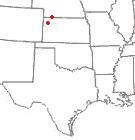|

Colby, Kansas | Roger,
The grid cell size issue is a question that no one, I believe, has a good answer to yet. The only certain thing is you should be conscious of the response capabilities of your application device for the speed you intend to operate. The concern there is that unless the prescription is relatively smooth from cell to cell, you controller will spend all of its time hunting, thus oscillating, and you end up with a mess.
Also be aware than the smaller the cell size, the more opportunity for an erroneous yield data point to skew your prescription. The other side of that is getting cells that are so large you are essentially moving closer to a zone or whole field management and at that scale, whats the point? I guess everything in life is a trade off.
What width is your spread (I assume your using a dry spinner, or dry boom), and what width are your combine passes. What are you using to spread (that will give me an idea on what type of response time you have) Here is typically what I do, most of my work is done in MapInfo because thats just what I have and what I'm used to, Of the commercial packages I would have the most confidence in being able to do this with MapShots and the IntelliCalc option.
1. Create a grid - 80' may work well, thats 4 combine passes at 8 rows, at 4 mph and 1 hz data points would give about 52 yield data points to average, but thats kind of small for an applicator traveling at 12 mph (4.5 seconds to travel across the cell). So if you went 160' that would give you about 0.6 acre cells and around 200 yield points to average.
2. Filter the yield data - I use ARS YieldEditor. I use the time delay shifts and the speed change filter.
3. Average the yield data points that fall within each cell to obtain a cell average yield.
4. Calculate removal for each cell (.5 lb P per 1 bu. wheat or whatever your figure is) based on the cell average yield
5. Add removal value to any desired soil test build based on soil sampling and management desires
Of course a multi product application may involve some other arithmetic to get total application right. For example we maintain a constant N rate so in a VRT phos situation any change in what we apply in 10-34-0 must be compensated in our 32-0-0 application so that total N still comes to 80 lb.
In many of our fields we have a lot of point rows, partial header widths (i.e. wheat harvest), so to aggregate yield data I use a variant of method called MPGM, this performs some other filtering and data quality thresholds.
I've rambled a bit here, sorry.
Lucas
Edited by LHaag 10/4/2007 12:55
| |
|


 Something for Everyone to Shoot Holes IN !! Moved From Crop Talk.
Something for Everyone to Shoot Holes IN !! Moved From Crop Talk.